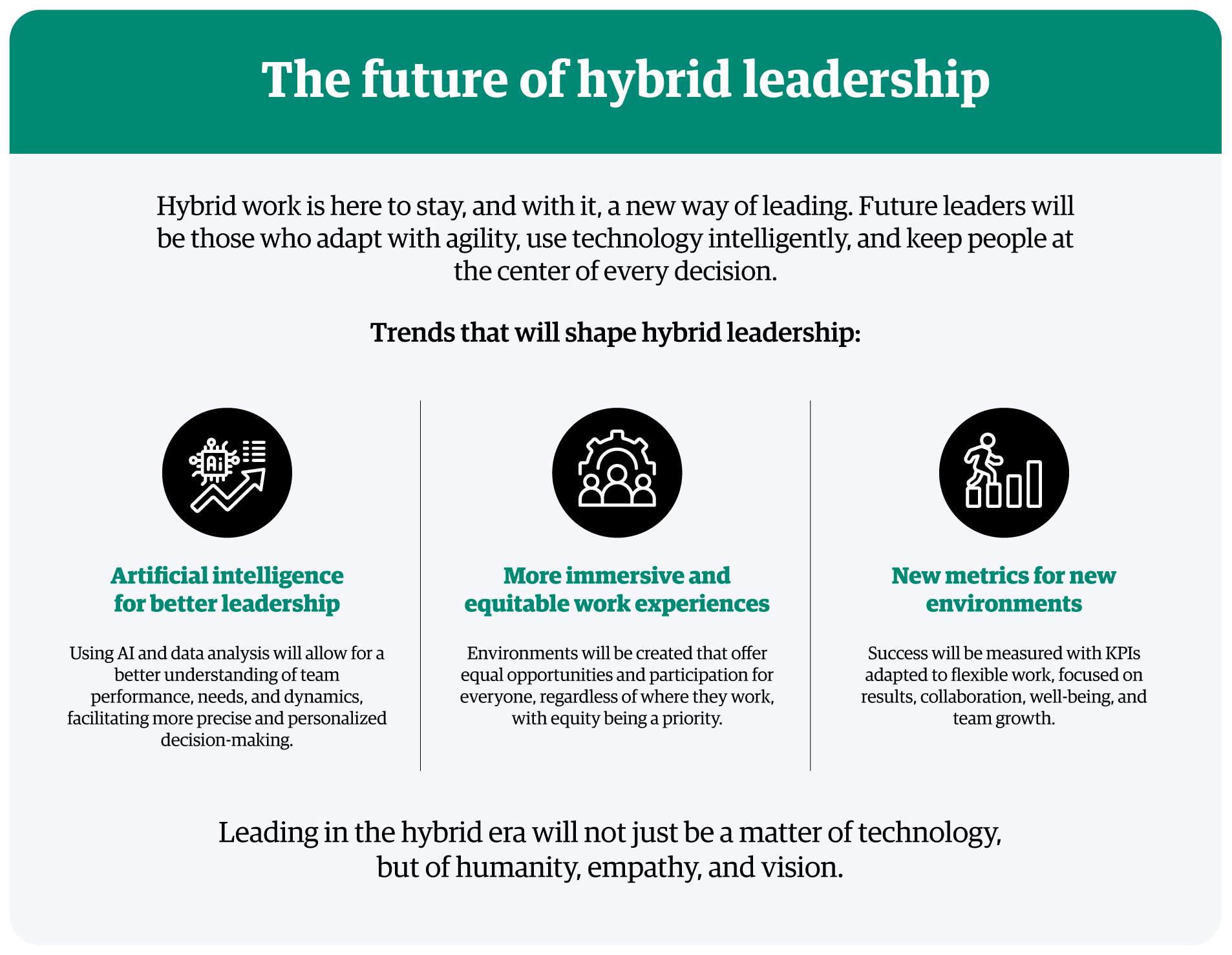Remote and hybrid work models have transformed the way organizations operate, making appropriate leadership essential.
Effective leadership is critical in today's environment, directly impacting staff performance and satisfaction by motivating, coordinating, and maintaining the commitment of distributed teams.
This article will examine various leadership models for remote and hybrid teams, alongside the primary challenges organizations encounter.
How are leadership models for hybrid and remote teams challenged?

Leading hybrid and remote teams demands a distinct approach compared to traditional leadership. The inherent challenges of distance and varied work experiences across different modalities necessitate clear, tailored solutions.
Maintaining fairness
A primary challenge involves guaranteeing equitable opportunities for all employees, encompassing development, visibility, and recognition, regardless of whether they work remotely or on-site.
It is imperative that leadership operates with a complete understanding of potential biases, undertaking intentional measures to fairly allocate tasks, benefits, and access to resources.
Effective communication
In distributed teams, effective communication is paramount. Establishing clear, accessible, and consistent communication channels is essential to keep all team members informed.
Leaders must also actively foster environments where every voice is heard, preventing remote workers from feeling isolated.
Building organizational culture

Cultivating a sense of belonging in distributed teams demands ongoing dedication. Leaders must consistently communicate organizational values, reinforce a shared purpose, and actively create opportunities for connection in every interaction. This approach is crucial for sustaining the company culture, even in the absence of daily face-to-face contact.
Performance management
In hybrid work settings, evaluating performance requires a shift from tracking attendance to prioritizing results. This involves establishing clear goals, consistent monitoring, and personalized feedback.
Leadership should concentrate on inspiring through accomplishments and building trust in each team member's independence.
Technology and tools
Beyond merely providing the right tools, it's crucial to guarantee their proper implementation and utilization.
Leadership must champion proficiency in collaborative platforms and ensure universal team access, thereby eliminating any technical obstacles that could impede productivity or inclusion.

How can you have an effective leadership model for hybrid and remote teams?

Successfully leading in hybrid and remote settings demands specific strategies to conquer the hurdles of coordination, communication, and managing remote teams. Let's briefly delve into how to achieve this effectively.
Establish clear and consistent communication
Effective communication is paramount. Establishing formal channels for sharing crucial information and organizing regular full-team meetings, inclusive of both remote and on-site staff, is essential.
Additionally, fostering informal interactions, such as quick chats or brief virtual get-togethers, helps to strengthen team bonds.
Promoting inclusion and equity
Leadership should guarantee equitable development opportunities for all employees, irrespective of their location. This includes fair recognition of accomplishments and meeting scheduling that accommodates various time zones.
To ensure fairness, remote work must have the same visibility as on-site work.
Foster a culture of trust and autonomy
A results-based management approach is crucial, requiring leaders to prioritize defined objectives over physical oversight.
By entrusting employees with autonomy in managing their time and tasks, and providing support only when necessary, leaders can enhance commitment and optimize individual performance.
Leveraging technology effectively

Technology should simplify collaboration, not hinder it. It's vital to select user-friendly tools and provide continuous training.
Furthermore, careful planning of hybrid meetings is essential to guarantee an equitable experience for all attendees, regardless of their location.
Customize your leadership approach
Employees have diverse needs, with some preferring more interaction and others greater autonomy. Therefore, it's vital to customize communication, management, and support for each individual.
Regular check-ins are key to understanding these unique needs and providing appropriate, tailored support.
Maintaining well-being and work-life balance
In a hybrid work model, leaders must emphasize respect for personal time and promote self-care by modeling healthy habits to prevent the blurring of lines between work and personal life.
All wellness programs should be readily available to every team member, regardless of their work setup.
What are some leadership models?
|
Type of leadership |
Brief description |
When should it be applied? |
Key features |
|
Authoritarian (Autocratic) |
The leader concentrates authority and makes decisions without consulting the team. |
When speed is required or the leader is the most experienced. |
- Unilateral decisions - Expected obedience - Reward and punishment system - Focus on results, not creativity |
|
Democratic (Participatory) |
Involve the team in decision-making to foster commitment. |
Ideal for collaborative environments such as startups and modern companies. |
- Active participation of the team - Spaces for expressing opinions - Decisions consulted - Encouraging creativity - Slower decisions |
|
Laissez-faire (Delegative) |
The leader delegates and gives the team freedom to make decisions. |
Useful with expert and autonomous teams. |
- High autonomy - Shared objectives - Low supervision - Freedom to experiment and decide |
|
Transactional |
It is based on rewards and consequences according to performance. |
Effective in situations requiring short-term results. |
- Focus on results - Performance-based rewards - Little room for creativity - Indirect influence |
|
Transformational |
Motivate and inspire the team, seeking their personal and professional growth. |
Recommended in cultures focused on continuous improvement and innovation. |
- Enthusiastic leader - Inspire with vision - Good communication skills - High standards and positive pressure |
|
Bureaucratic |
Strictly follow the rules and processes established by the organization. |
Suitable for regulated or high-risk environments (finance, security, etc.). |
- Rule-based authority - Resistance to change - Requires high precision - Focus on compliance |
|
Coaching (Coach) |
It focuses on developing individual strengths aligned with objectives. |
Essential in remote or distributed teams with a high degree of autonomy. |
- Identify and develop talent - Promotes belonging - Constructive communication - High emotional intelligence |
|
Natural |
Informal leadership based on personal skills, not hierarchical position. |
It arises spontaneously when a person has a positive influence on their environment. |
- Spontaneous recognition - High empathy and communication skills - Influence without formal authority |
Effective human capital management with London Consulting Group

At London Consulting Group, we specialize in elevating human capital by implementing leadership models specifically designed for the complexities of hybrid and remote work.
Leading distributed teams demands new proficiencies, adaptable structures, and strategic talent management. Our solutions are crafted to align individual development with business objectives, thereby optimizing performance and engagement across all work modalities.
We champion leadership that consistently delivers results in dynamic environments. We establish efficient processes for attracting, developing, evaluating, and retaining talent, emphasizing equity, autonomy, and collaboration within hybrid teams.
Through forward-thinking strategies, we create tangible transformations that empower human capital as the primary catalyst for organizational growth.
Optimize your team's leadership with London Consulting Group. Contact us to explore our solutions.


